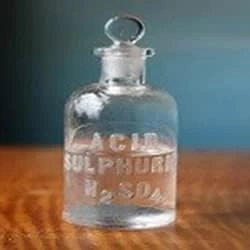IUPAC Name
Sulfuric Acid
Cas Number
7664-93-9
HS Code
2807.00.00
Formula
H2SO4
Appearance
Clear Liquid
Common Names
Hydrogen sulfate, Vitriol brown oil, Oil of vitriol
Packaging
50 kg drum
Brief Overview
Sulphuric acid, also known as Hydrogen Sulphate, is classified as diprotic acid and strong acid with molecular formula H2SO4. The physical properties of sulphuric acid are colorless to slightly yellow liquid. It was known as the oil of vitriol. Sulphuric acid is very soluble in water in every concentration. Sulphuric acid does not occur in nature in anhydrous form because of its hygroscopic properties, which can absorb water vapor from the air. Sulphuric acid formed in nature by the oxidation reaction of sulfide minerals.
Manufacturing Process
The manufacturing process of sulphuric acid is using the Chamber process only produced approximately 65% concentration. There are several methods of manufacturing sulphuric acid as follows:
Contact Process
This is the most common manufacturing process in the industry because the sulphuric acids that obtain from this process are in high concentration and also less expensive than other methods. The contact process also used for fuming sulphuric acid from sulphur dioxide. This process is occurring by roasting sulphide ores or burning sulphur with oxygen in the presence of vanadium (V) oxide catalyst and classified as an exothermic reaction. This method comprises four steps:
i. Producing sulphur dioxide by burning sulphur S(s) + O2(g) = SO2(g)
ii. Oxidation reaction of sulphur dioxide to produce sulphur trioxide 2SO2(g) + O2(g) = 2SO3(g) (V2O5 Catalyst)
iii. Absorption of sulphur trioxide into H2SO4 (97-98 %) to produce oleum (H2S2O7(l)) H2SO4(l) + SO3(g) = H2S2O7(l)
iv. Dilution of oleum with water to produce sulphuric acid in a certain concentration H2S2O7(l) + H2O(l) = 2H2SO4(l) Wet Sulphuric Acid (WSA) Process WSA process is largely used in industry for recovering sulphur.
There are 4 main reactions in the WSA process, which is combustion, oxidation, hydration, and condensation. WSA process is classified as an exothermic reaction and the heat released by the reaction is used for the production of steam. The process of making sulphuric acid using the WSA process in the presence of vanadium (V) oxide catalyst is shown below:
i. Combustion: H2S + ½ O2 = H2O + SO2
ii. Oxidation: 2SO2(g) + O2(g) = 2SO3(g) (V2O5 Catalyst)
iii. Hydration: SO3 + H2O = H2SO4(g)
iv. Condensation: H2SO4(g) = H2SO4(l)
Metabisulfite Process
This method is using sodium metabisulfite or potassium metabisulfite as the main material for producing sulphuric acid. Metabisulfide is added with hydrochloric acid with a concentration of 12.6 molars and produces sulphur dioxide. This production of sulfur dioxide is easier than burning sulphur. Then sulphur dioxide is converted to sulfuric acid by reacting it in water that contains oxidizer such as nitric acid or hydrogen peroxide. The reaction is shown below:
SO2 + H2O2 = H2SO4
Paint Industry
Sulfuric acid has a broad range of applications, involving the manufacture of fertilizers, pigments, dyes, drugs, explosives, detergents, and inorganic salts and acids. The major use is in the manufacture of fertilizer to improve plant growth. It is also used as an important chemical compound to produce popular acids like Nitric Acid and Hydrochloric and used as a catalyst to refine oil.
Agriculture Industry
Each year, about 30% of sulphuric acid production is used to make fertilizer. It is used in fertilizer like ammonium sulphate and super phosphate of lime as a dehydrating agent so the ground will not be overhydrated and too saturated. Phosphoric acid that contains in super phosphate fertilizer is produced from the reaction of sulphuric acid with phosphate rock. Ammonia, in the form of gas, is reacted with sulphuric acid to produce ammonium sulphate fertilizer and easily absorbed by plant roots. It is also used in fertilizer as nutritive values and improves fertilizer efficiency.
Detergent Industry
Sulfuric acid is often used as a dehydrating agent when manufacturing dyes, detergents, and explosive devices. It effectively draws out condensation and moisture from a diverse range of substances. For example, when sulfuric acid is poured on sugar crystals, the compound removes 11 molecules of water for every molecule of sucrose, leaving a spongy, brittle mass of carbon. The drying properties of sulfuric acid make it corrosive and cause burns on the skin.
Electronic and Automotive Industry
Sulphuric acid is used in lead-acid batteries for cars and other vehicles. Sulphuric acid is usually mixed with water to create a chemical reaction that produces an electron to make the charge that needed to start the vehicle. The electron also circulates through the cathode to allow a safe method for removal of the used electron, because the electron charge cannot be used again by the battery.
Water Treatment Industry
For wastewater treatment, sulphuric acid is used to remove impurities from various substances. Sulphuric acid is used to neutralize the water that contaminates from basic substance and also use to break emulsions. It also used in drinking water treatment to create an improved taste and remove impurities. It also used as a raw material in the production of another wastewater treatment compound such as aluminium sulphate.
Other Applications
In an oil refinery, sulphuric acid is used as a catalyst in the production of isooctane. In the steel industry, sulphuric acid is used to remove rust and oxidation. Because of its strong acidic properties, sulphuric acid is used as pH neutralization for a certain strong basic solution such as sodium hydroxide, calcium carbonate, or lime suspension. The neutralization reaction can raise the temperature. In the pulp industry, sulphuric acid is used as a pH regulator when recovering pulp chemicals and to produce chlorine dioxide for bleaching.
